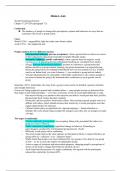Thema 3 – I spy
Social Psychology [Kassin]
Chapter 7 (270-285) (paragraph 7-2)
Conformity
The tendency of people to change their perceptions, opinion and behaviour in ways that are
consistent with social or group norms.
Cases
Sherif (1936) – suggestibility light dot study (auto kinetic study)
Asch (1951) – line judgement task
People conform for two different reasons:
- Informational influence (private acceptance): when a person believes others are correct
in their judgements (big group of people) (example Muzafer study).
- Normative influence (public conformity): when a person fears the negative social
consequences of appearing deviant (afwijkend) (smoking ex.) (example Asch study).
- [Hogg] Referent informational influence: pressure to conform to a group norm that
defines oneself as a group member (mening van groep meenemen in je eigen beleving -
binnen de groep heb je een standaard ontwikkeld wat voor jou normaal is). (Ex. Friends
want to eat Indian food, you want Lebanese -> you conform to group and eat Indian).
- Verschil informationele en referentiële: referentiële conformeer je obv normen (omdat er
een norm is binnen de groep), Bij informationele conformeer je op de grootte van de
groep.
Schachter (1951): individuals who stray from a group’s norm tend to be disliked, rejected, ridiculed
and outright dismissed.
Ostracised: being neglected, ignored and excluded online -> some people become so distressed that
they begin to feel numb/sad/angry -> over time, it becomes a form of social death/difficulty to cope.
- Our need to belong is so primitive that rejection can inflict a social pain that feels just like
physical pain (hurt, broken hearted, crushed)
- Social pain can have positive motivations effects. Once feeling rejected, people seek to re-
affiliate with others, which should increase their sensitivity to social perception cues that
signals opportunities for inclusion.
- Cultural context plays an important role: ingroup/outgroup -> farmers/herders ex.
(Herders felt worse about being excluded by strangers since they rely on strangers to make
a living).
Two types of conformity
- Private conformity (conversion): true accepting. Being truly persuaded that others in a
group are correct {Sherrif}.
- Public conformity (compliance): superficial change in behavior. Pretending to
agree/disagree, produced by real/imagined group pressure {Asch}.
- Difficulty in task plays role in conformity
- The more people express the same opinion, an individual is likely to suspect that they are
acting either in ‘’collusion’’ or as ‘’spineless sheep’’.
- Wilder found that people were more influenced by two groups of two than by one group
of four – we try to asses the number of independent minds.
- Across a range of situations and intervention purposes, changing people’s perceptions of
norms can be used to change their behavior (alcohol survey).
- Asch found that the presence of a single confederate who agreed with the participant
reduced the conformity by almost 80%.
, Conclusions:
- It is substantially more difficult for people to stand alone for their convictions that to be
part of even a tiny minority.
- Any dissent – whether it validates the opinion of an individual or not – can break the spell
cast by a unanimous majority and reduce the normative pressures to conform.
Gender differences
- Females conformed more on masculine items, males conformed more on feminine items.
This finding suggests that one’s familiarity with the issue at hand, not gender, is what
affects conformity.
- Social situation: When participants think they’re being observed, women conform more
and men conform less than they do in a more private situation – when primed to think
about themselves in a romantic situation.
- Both men and women alike were attracted to others who are nonconformists.
Minority influence
- > the process by which dissenters produce change within a group.
- Respondents who held minority opinions were slower to respond, than those in the
majority.
Moscovici’s theory:
Majorities are more powerful by virtue of their sheer numbers, whereas nonconformists derive
power from the style of their behavior (how they say it).
Idiosyncracy credits: interpersonal ‘credits’ that a person earns by following group norms
(Credits opbouwen om jezelf te kunnen zijn).
Process and outcomes of minority influence
- Majorities, because they have power and control, elicit public conformity by bringing
stressful normative pressures to bear on the individual.
- Minorities, because they are seen as seriously committed to their views, produce a deeper
and more lasting form of private conformity, or conversion, by leading others to become
curious and rethink their original positions.
- Two conclusions can be drawn: the relative impact of minorities and majorities depends
on whether the judgement that is being made is objective or subjective.
- Majorities have greater influence on factual questions, for which only one answer is
correct.
- Minorities exert equal impact on opinion questions, for which there is a range of
acceptable responses.
- 2nd: the relative effects of majority and minority points of view depend on how and when
conformity is measures.
- Majorities have an upper hand on direct/public measures of conformity.
- On more indirect/private measures of conformity, minorities exert a strong impact.
Culture and conformity
- Individualism: a cultural orientation in which independence, autonomy and self-reliance
take priority over group allegiances.
- Collectivism: a cultural orientation in which interdependence, cooperation and social
harmony take priority over personal goals.
- Three key factors: complexity of a society, affluence, heterogeneity
- Conformity rates are generally higher in cultures that are collectivistic rather than
individualistic in orientation.





